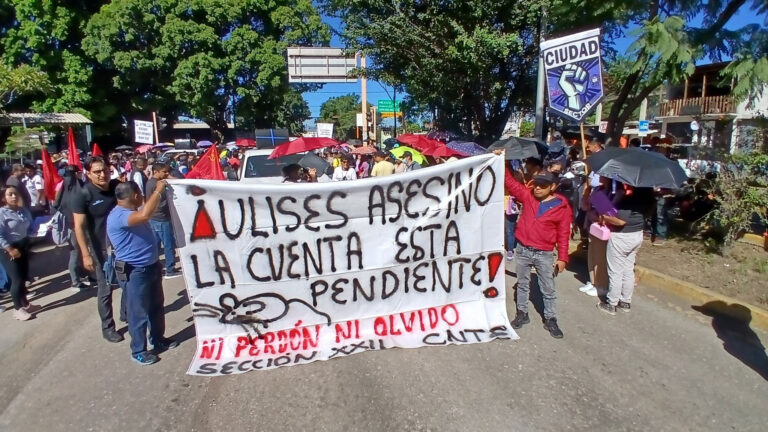TEACHERS’ RESISTANCE
This editorial by Hugo Aboites appeared in the May 24, 2025 edition of La Jornada, Mexico’s premier leftist daily newspaper.
Years ago, Luz Elena Galván Lafarga, a researcher reviewing the enormous piles of mail President Porfirio Díaz had received between 1908 and 1910, realized that the majority, 47,000, were letters from teachers. Considering that at that time the total number of teachers in the country was no more than 12,000, this meant that the teachers were doing the only thing they could do at the time: insisting, pleading, over and over again.
Many of them were teachers, but also men, asked for help and petitioned the highest authority for a position—even a distant one—or for a pay raise or a pension, since they were old and destitute. The most pressing issue was their salary, since except in some places—where teachers were most needed—where salaries could approach 100 pesos a month, the usual wage was 40 pesos, and in the villages, it was only 10 pesos.
In her writing Maestras y maestros en el tiempo (2016), the researcher from the Center for Research and Higher Studies in Social Anthropology (Ciesas) had analyzed the salaries of other professions, and found that there was not a single state analyzed where the salaries of teachers were equal to or higher than those of day laborers.
There was also the complaint that in Mexico City a soldier earned 90 pesos and a teacher barely 40 (even today the disparity is clear: a new teacher earns 8,000 pesos, a new soldier 12,000). The most moving letters were those from single women, teachers who had to double as seamstresses to support their families, and teachers who would receive a ridiculously low pension.
As they learned from the Revolution, teachers don’t beg: they resist and insist.
But also noteworthy are the writings of elderly teachers asking General Díaz to provide them with clothing, as their jackets are already worn and they fear losing their jobs. Others ask him for books (and attach their diplomas) because they want to improve their education. But there was almost never a positive response. Justo Sierra, then Secretary of Education and Fine Arts, called the teachers “apostles” and “heroics” and acknowledged their shortcomings, but he repeated, “We don’t have a budget,” and blamed Ives Limantour, the Secretary of the Treasury.
That’s why, a few months later, when the first clashes against the government of Porfirio Díaz and his armed forces took place in Chihuahua and Puebla, many teachers sided with the revolutionaries. And, with her characteristic tenacity, Professor Galván compiled a list of those who were “certainly with the movement.” Many of them fought directly alongside Francisco Villa and Emiliano Zapata, but also with Venustiano Carranza and Álvaro Obregón, while the women were couriers, nurses, and journalists.
Several of these teachers later inspired educational reformers, notable politicians, and even presidents. But, unfortunately, in the struggle over which national project would be the fruit of the Revolution, Villa and Zapata didn’t win, and neither did Cárdenas later. Carranza, Obregón, and later Manuel Ávila Camacho, Miguel Alemán Valdés… and Gustavo Díaz Ordaz won, and the others who directly favored capital and rarely favored others.
Thus, President Carranza accepted a new Constitution only reluctantly—he preferred the one of 1857—and with difficulty admitted that it would include land distribution and labor rights, and education as only a minimal addition to the role of the state. Furthermore, almost as if to make his orientation clear, he appointed Félix Palavicini as Secretary of Education, someone he described as seeking to “civilize the lower classes for the use of the upper classes,” because “if the children of the working classes remained uneducated, uncontrollable passions of greed, hatred, and envy would erupt, and anarchism and communism would take over the country.”
It accepts “the rights of labor, but on the assumption that labor is subject to the needs of capital and obeys its laws” (Meneses Morales et al.: Official Educational Trends in Mexico: 148). This proposal explains why teachers and students have repeatedly and insistently opposed several Palavacinis in the current SEP and their educational projects.
And so, now, the CNTE teachers’ union, which turned Enrique Peña Nieto and his administration into a political corpse and overturned education reform, is demanding that the current government repair the terribly unjust reduction in pensions (a two-thirds reduction); break with a tradition that places teachers in the background compared to soldiers; and repeal, among others, the ISSSTE Law, because it implies obedience to the sacred law of respecting capital (and not taxing it like everyone else); respecting the Morena agreement with the PAN in the 2019-2021 laws; and educating children and young people in the fantasy of harmonious development. And so, today, discontent and rebellion are growing here and there. And as they learned from the Revolution, teachers don’t beg: they resist and insist.
-
CNTE Will Strike, Protest in 2026 so President Sheinbaum Keeps Promise to Repeal Calderón’s ISSSTE Law
The teachers union will mobilize to ensure the Mexican President honours her 2024 campaign promise.
-
CNTE Sets Up Protest Outside Mexico’s Chamber of Deputies
The CNTE teachers’ union leadership pointed out that the federal government “has only offered delaying tactics; its statements are far from the reality experienced by thousands of teachers throughout the country.”
-
CNTE Teachers Thwart Right Wing Party Assembly
Teachers from Valles Centrales disrupted a political event orchestrated for a new party being formed by ex-governor of Oaxaca Ulises Ruiz Ortiz , responsible for repression against teachers in 2006 which led to 20 murders & multiple disappearances.




